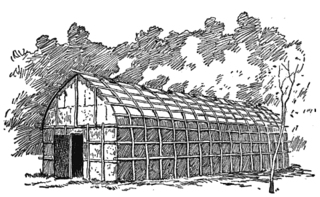 | Back to e-WV
| Back to e-WV
 The West Virginia Encyclopedia
The West Virginia Encyclopedia
 | Back to e-WV
| Back to e-WV
 The West Virginia Encyclopedia
The West Virginia Encyclopedia

The League of the Iroquois was a French term for a confederacy of native peoples speaking related languages and living in contiguous territory during colonial times in what is now upstate New York. The confederates themselves called their league ‘‘the longhouse,’’ metaphorically invoking the typical communal dwelling of their culture. Dutch and English colonists called the league ‘‘the Five Nations,’’ for the Mohawk, Oneida, Onondaga, Cayuga, and Seneca. After 1722, this became the Six Nations as the league admitted the Tuscaroras. While not resident in the territory that became West Virginia, the Iroquois exerted influence over the region and on the development of the Appalachian frontier.
Legend attributes the origin of the league to two founders, the supernatural Deganawidah and the mortal Hiawatha. Apparently the confederacy was in existence a generation or two before Iroquoian-speakers first encountered European explorers in 1534. After an initial period of disadvantage when European diseases devastated Iroquois longhouses and the league was cut off by rivals from the earliest beachheads of European trade, the geographical location of the league proved to be advantageous. Through trade and diplomacy, the Iroquois were able to play off Europeans in Canada—successively the French and the British—against those in the Middle Atlantic regions—successively the Dutch, English, and Americans. As a result, the confederacy retained its independence and influence from the mid-17th to the late 18th centuries.
The Iroquois also claimed dominion over other native societies, first by conquest during the Indian wars of the mid-17th century and later by establishing a sort of protectorate over non-Iroquoian peoples such as the Lenape (Delaware). Iroquois conquest is thought to be one explanation—along with European diseases—for the depopulation of native peoples in what is now West Virginia during the 17th century. It was also the basis of the confederacy’s territorial claim to the upper Ohio Valley, a claim that colonial negotiators found convenient to accept, since alliance with the Iroquois allowed the British to assert ownership of interior territories that had been explored mainly by their rival claimants, the French. The French accepted this claim in the Treaty of Utrecht in 1713 but continued to compete for trade and influence in Iroquoia until they finally gave up all their North American territories at the end of the French and Indian War (1763).
Except for brief sojourns by Tuscaroras en route to their new home in New York, Iroquois did not live in Western Virginia during the 18th century, although they continued to hunt here, especially the Senecas. Thus Virginia negotiators were able to buy their claim to the land between the ‘‘back mountains of Virginia’’ and the Ohio River at the Treaty of Lancaster in 1744. (Or so the Virginians asserted; Iroquois leaders denied making such an extensive grant and sold it again at the Treaty of Fort Stanwix in 1768.) The Lancaster treaty stimulated an influx of speculators and settlers into lands west of the Alleghenies, beginning in the Greenbrier, New River, and Monongahela watersheds. This in turn set in motion 50 years of intermittent border warfare, as non-Iroquoian peoples such as the Shawnees and Delawares who had not been consulted at Lancaster disputed the Virginian advance into their traditional hunting grounds. At times the Iroquois ‘‘uncles’’ of these peoples sought to restrain them; at other times, Iroquois warriors, especially Senecas, joined in the fighting.
After the American Revolution, the Shawnees denounced the Six Nations’ failure to protect their dependents and allies from the relentless Euro-American advance and set about organizing a rival western confederacy. Thereafter the Iroquois could speak only for themselves, and their role in the Ohio Valley dwindled to the maintenance of a small Seneca reservation on the region’s northern edge.
Written by John Alexander Williams
Richter, Daniel K. The Ordeal of the Longhouse: The Peoples of the Iroquois League in the Era of European Colonization. Chapel Hill: University of North Carolina Press, 1992.